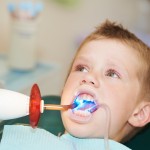
Fissure sealants have been available since the 1960’s and a 2008 Cochrane review by Ahovuo-Saloranta et al highlighted their effectiveness for preventing occlusal caries noting that their effectiveness is obvious in high caries risk children. The aim of this new study by Muller-Bolla et al, was to assess their effectiveness in a school-based dental sealant (SBDS) programme.
First grade French children from low-income backgrounds with erupted first molar tooth pairs (36–46 and/or 16–26) were randomised to have one of each pair sealed. When both pairs were included a maxillary and mandibular permanent molar on opposite sides were sealed. The primary outcome was the occurrence of new caries (ICDAS code 3–6) at the 1-year follow-up. Streptococcus mutans (SM) and Lactobacillus counts were recorded at baseline to assess caries risk.
- 343 Children were consented and 253 (91.7%) of the 276 children who had sealants placed completed a 1-year of follow-up visit.
- At the 1-year follow-up,
- sealant retention was noted in 52.7% (n = 222) of the treated teeth.
- In the adjusted analysis, molars that received sealants were less at risk of developing new caries compared with those from the control group (OR = 0.26, 95% CI: 0.14-0.49).
- The effect of the sealants was significant only when the analyses included subjects with active caries (OR = 0.25; 95% CI: 0.12-0.50) or with a high SM count (>10(5) , OR = 0.20; 95% CI: 0.10-0.41) at baseline.
- Retention in the maxilla was significantly lower than that in the permanent mandibular molars.
The authors concluded
The 1-year effectiveness of the SBDS program was demonstrated in low socio-economic areas. Selection of schoolchildren according to individual caries risk factors should be considered in a SBDS program.
Comment
The results of this pragmatic community–based trial points to a significant benefit at one year for high risk children. The 2008 Cochrane review also indicated a more long-term benefit finding that,
after 4.5 years the sealed permanent molar teeth of children aged 5 to 10 had over 50% reduction in decay on biting surfaces compared to teeth without sealants. One study with longer follow up showed that after 9 years only 27% of sealed tooth surfaces were decayed compared to 77% of tooth surfaces without sealant.
It is also worth noting that another Cochrane review (Hiiri A et al 2010) suggested that the benefit from sealants might be greater than fluoride varnish applications.
Links
Muller-Bolla M, Lupi-Pégurier L, Bardakjian H, Velly AM. Effectiveness of school-based dental sealant programs among children from low-income backgrounds in France: a pragmatic randomized clinical trial. Community Dent Oral Epidemiol. 2012 Oct 17. doi: 10.1111/cdoe.12011. [Epub ahead of print] PubMed PMID: 23072366.
Ahovuo-Saloranta A, Hiiri A, Nordblad A, Mäkelä M, Worthington HV. Pit and fissure sealants for preventing dental decay in the permanent teeth of children and adolescents. Cochrane Database Syst Rev. 2008 Oct 8;(4):CD001830. Review. PubMed PMID: 18843625.
Hiiri A, Ahovuo-Saloranta A, Nordblad A, Mäkelä M. Pit and fissure sealants versus fluoride varnishes for preventing dental decay in children and adolescents. Cochrane Database Syst Rev. 2010 Mar 17;(3):CD003067. Review. PubMed PMID: 20238319.
